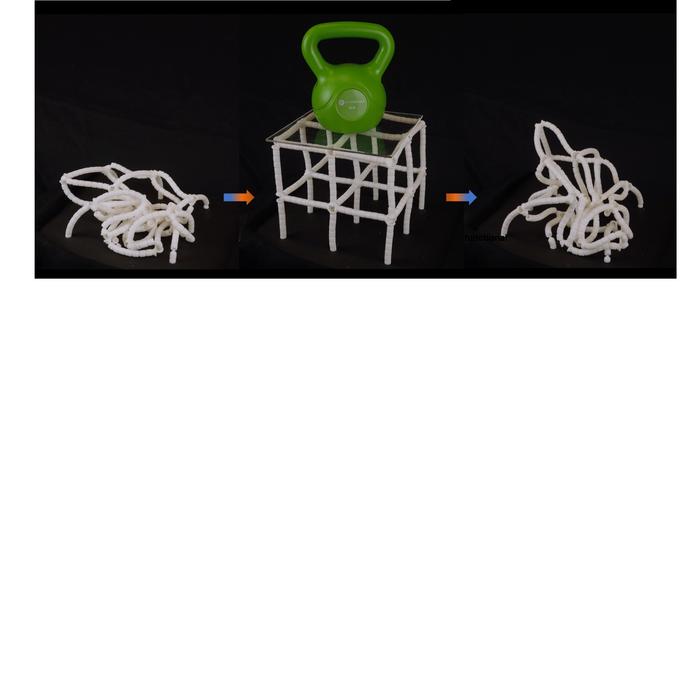Common push puppet toys in the shapes of animals and popular figures can move or collapse with the push of a button at the bottom of the toys’ base. Now, a team of UCLA engineers has created a new class of tunable dynamic material that mimics the inner workings of push puppets, with applications for soft robotics, reconfigurable architectures and space engineering.

Credit: Wenzhong Yan/UCLA
Common push puppet toys in the shapes of animals and popular figures can move or collapse with the push of a button at the bottom of the toys’ base. Now, a team of UCLA engineers has created a new class of tunable dynamic material that mimics the inner workings of push puppets, with applications for soft robotics, reconfigurable architectures and space engineering.
Inside a push puppet, there are connecting cords that, when pulled taught, will make the toy stand stiff. But by loosening these cords, the “limbs” of the toy will go limp. Using the same cord tension-based principle that controls a puppet, researchers have developed a new type of metamaterial, a material engineered to possess properties with promising advanced capabilities.
Published in Materials Horizons, the UCLA study demonstrates the new lightweight metamaterial, which is outfitted with either motor-driven or self-actuating cords that are threaded through interlocking cone-tipped beads. When activated, the cords are pulled tight, causing the nesting chain of bead particles to jam and straighten into a line, making the material turn stiff while maintaining its overall structure.
The study also unveiled the material’s versatile qualities that could lead to its eventual incorporation into soft robotics or other reconfigurable structures:
- The level of tension in the cords can “tune” the resulting structure’s stiffness — a fully taut state offers the strongest and stiffest level, but incremental changes in the cords’ tension allow the structure to flex while still offering strength. The key is the precision geometry of the nesting cones and the friction between them.
- Structures that use the design can collapse and stiffen over and over again, making them useful for long-lasting designs that require repeated movements. The material also offers easier transportation and storage when in its undeployed, limp state.
- After deployment, the material exhibits pronounced tunability, becoming more than 35 times stiffer and changing its damping capability by 50%.
- The metamaterial could be designed to self-actuate, through artificial tendons that trigger the shape without human control
“Our metamaterial enables new capabilities, showing great potential for its incorporation into robotics, reconfigurable structures and space engineering,” said corresponding author and UCLA Samueli School of Engineering postdoctoral scholar Wenzhong Yan. “Built with this material, a self-deployable soft robot, for example, could calibrate its limbs’ stiffness to accommodate different terrains for optimal movement while retaining its body structure. The sturdy metamaterial could also help a robot lift, push or pull objects.”
“The general concept of contracting-cord metamaterials opens up intriguing possibilities on how to build mechanical intelligence into robots and other devices,” Yan said.
A 12-second video of the metamaterial in action is available here, via the UCLA Samueli YouTube Channel.
Senior authors on the paper are Ankur Mehta, a UCLA Samueli associate professor of electrical and computer engineering and director of the Laboratory for Embedded Machines and Ubiquitous Robots of which Yan is a member, and Jonathan Hopkins, a professor of mechanical and aerospace engineering who leads UCLA’s Flexible Research Group.
According to the researchers, potential applications of the material also include self-assembling shelters with shells that encapsulate a collapsible scaffolding. It could also serve as a compact shock absorber with programmable dampening capabilities for vehicles moving through rough environments.
“Looking ahead, there’s a vast space to explore in tailoring and customizing capabilities by altering the size and shape of the beads, as well as how they are connected,” said Mehta, who also has a UCLA faculty appointment in mechanical and aerospace engineering.
While previous research has explored contracting cords, this paper has delved into the mechanical properties of such a system, including the ideal shapes for bead alignment, self-assembly and the ability to be tuned to hold their overall framework.
Other authors of the paper are UCLA mechanical engineering graduate students Talmage Jones and Ryan Lee — both members of Hopkins’ lab, and Christopher Jawetz, a Georgia Institute of Technology graduate student who participated in the research as a member of Hopkins’ lab while he was an undergraduate aerospace engineering student at UCLA.
The research was funded by the Office of Naval Research and the Defense Advanced Research Projects Agency, with additional support from the Air Force Office of Scientific Research, as well as computing and storage services from the UCLA Office of Advanced Research Computing.
Journal
Materials Horizons
Method of Research
Experimental study
Subject of Research
Not applicable
Article Title
Self-deployable contracting-cord metamaterials with tunable mechanical properties
Article Publication Date
3-Jul-2024
COI Statement
The authors declare no competing interests.



